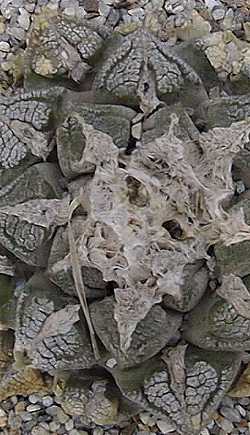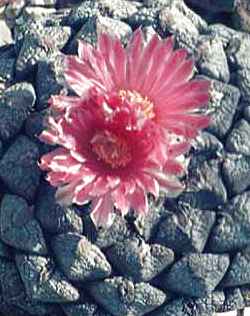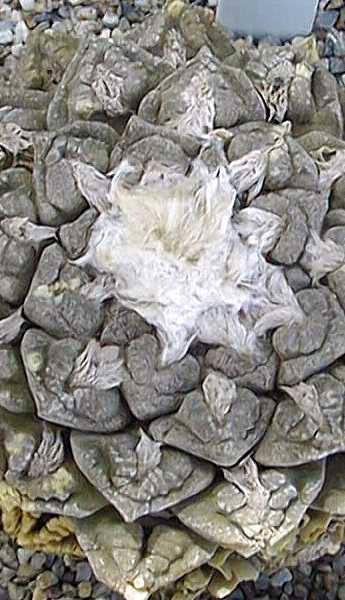Chautle Living Rock, False Peyote
Scientific Name: Ariocarpus fissuratus (Engelm.) K. Schum.
Synonym: Anhalonium fissuratum, Ariocarpus fissuratus var. lloydii , Ariocarpus lloydii, Mammillaria fissurata, Roseocactus fissuratus, Roseocactus intermedius
Family: Cactaceae
Sunset®: 11-13
USDA: 8b-11
Frost Tolerance: Hardy to 15°F (-10°C)
Sun Exposure: Full sun
Origin: USA (Texas, New Mexico), northern Mexico (Coahuila, Chihuahua and Durango)
Growth Habits: Solitary, grows extremely slowly to 8 inches in diameter (20 cm)
Watering Needs: Little to no water in winter, little in summer, needs good drainage
Propagation: Seeds, grafted to accelerate growth

The tubercles of Ariocarpus fissuratus are covered with fissures, hence the name. The plant looks closely like a rock (or some might say to a sun dried cow pie). It is quite difficult to locate in the wild.
The plants encountered as A. fissuratus var. lloydii have smoother tubercles, often without a fissure.

Ariocarpus fissuratus at Holly Gate (Photo Terry Hewitt)
Blooming Habits:
The Ariocarpus fissuratus has large, diurnal, 1.5 inches in diameter (4 cm), pale to deep pink satin flowers in mid summer, followed by fruit buried in the wool.
Culture:
The Ariocarpus are rare slow growing cacti, a 6 inches in diameter mature specimen might be 20 years old. For many years the large mature specimens were collected in the wild, practice that has been severely limited by the new regulations, either in Mexico or in international trade. They are not adapted as house plants as they need a lot of sun and careful watering. The large taproot needs enough room to grow, which complicates the good drainage requirement, since the deeper the pot, the slower it drains.
The center growing part is sensitive to mealybugs attacks. Since this part is woolly, mealy bugs can be difficult to notice. The plant should be treated as soon as mealybugs are noticed.
Desert-Tropicals is dedicated to provide gardening advice, gardening ideas, and information about flower of all kind for landscape and collections.We try to check carefully the identification of the plants on the illustrations as well as the other information from the page, but occasionally errors do occur. if you notice anything that needs to be changed please contact us.Thanks.
© 1998-2020 Philippe Faucon, All Rights Reserved.
